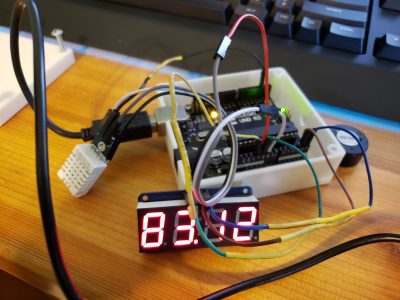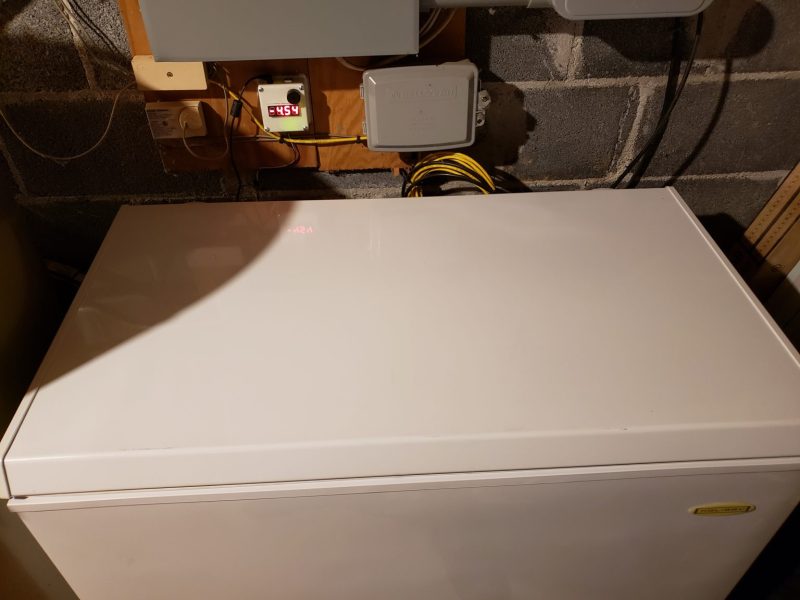Deep freezers are a great thing to have, especially when the world gets apocalyptic. Of course, freezers are only good when they’re operating properly. And since they’re usually chillin’ out of sight and full of precious goods, keeping an eye on them is important.
 When [Adam] started looking at commercial freezer alarms, he found that most of them are a joke. A bunch are battery-powered, and many people complain that they’re too quiet to do any good. And you’d best hope that the freezer fails while you’re home and awake, because they just stop sounding the alarm after a certain amount of time, probably to save battery.
When [Adam] started looking at commercial freezer alarms, he found that most of them are a joke. A bunch are battery-powered, and many people complain that they’re too quiet to do any good. And you’d best hope that the freezer fails while you’re home and awake, because they just stop sounding the alarm after a certain amount of time, probably to save battery.
If you want something done right, you have to do it yourself. [Adam]’s homemade freezer failure alarm is a cheap and open solution that ticks all the boxen. It runs on mains power and uses a 100dB piezo buzzer for ear-splitting effectiveness to alert [Adam] whenever the freezer is at 32°F/0°C or above.
If the Arduino loses sight of the DHT22 temperature sensor inside the freezer, then the alarm sounds continuously. And if [Adam] is ever curious about the temperature in the freezer, it’s right there on the 7-segment. Pretty elegant if you ask us. We’ve got the demo video thawing after the break, but you might wanna turn your sound down a lot.
You could assume that the freezer is freezing as long as it has power. In that case, just use a 555.
















Nice. But I’d have used an esp8266 so that you can check the temperature remotely via wi-fi as well.
I built a dual channel that interfaces with my home built automation system to keep an eye on refrigerator and freezer temps. Adding an audio playout next so the family can hear a stupid song when things go wrong. Also it will verbally tell the temp when button is pressed.
Use a temperature sensor with a thermostat output e.g. DS1631A can run in stand alone mode to take temperature and compare it with the Low and High threshold programmed into its EEPROM to drive a pin. The part talks I2C.
A really good start – I love playing with stuff like this and this would be a great entry-level project at many levels. It’s flexible enough to allow curious people to play with it quite a bit.
Some suggestions: Scanning the code, there’s no allowance for the normal use of people opening the freezer (which would quickly set off the alarm). Once temperature is exceeded, the code should allow a couple of minutes for things to get back to normal before sounding the “door open/freezer fail/sensor fail” alarm. Setting an error code on the display would be very helpful to distinguish among those, too. A general power failure setting would be good too, but that could add complexity (coding challenge in 3…2…1..).
(Also: “delay (3000); //wait 30 seconds” is 3 seconds.)
First, if the sensor has any thermal mass at all, it won’t be set off unless somebody leaves the freezer open for a significant period. Second, note that the pictured freezer is a top-opening, which means that the cold air tends to stay put, even when it is opened.
In that case it wouldn’t matter as the food would still be frozen. Same thing applies to your second point.
You are correct in that a sensor with thermal mass would damp the fluctuation to some degree.
In practical terms, If you open the freezer and go rooting around for the chicken you froze last November, the air gets stirred up pretty well, and that mass may not be enough. You can watch the air temperature fluctuate well above freezing for a while afterwards in my top-opening freezer.
This brings up another source of error, which is putting warm food in to freeze it, which will cause significant temperature shifts in the air mass as the heat is extracted.
Not bad. Mine uses an esp8266 with 3 tmp36 and an multi channel adc. Reads both the freezer and fridge along with ambient and backup battery voltage for my kitchen freezer. Chest freezer use another tmp36 with a huzzah from spark fun.
Forgot to include uses mqtt for communications and nagios with node red does the alerts/ automation
32 F is too warm to safely preserve frozen food. The recommend freezer temperature is 0 F. Refrigerator should be below 40 F
Yeah, I was thinking that most refrigeration alarms go off with at zero or ten degrees, gives you some time to fix it before stuff is totally thawed at 32…
But it also depends on the sensor placement, if it’s in free air above the food then 32 probably prevents nuisance alarms when the door opens.
But if it’s below the food level then I would want it set at 10 or 0. Very cool project though, and nicely documented which isn’t easy.
since when is 32f totally thawed
Since tolerances.
you cannot assume that because it has power it is freezing. I have a freezer that has a nasty habit ice dams forming above the condenser, and thus not defrosted by the auto-defroster. they back up into the air flow fan and block the blades , causing the freezer to get up to over 40°. Also, the DHT22 is probably a sufficient thermistor but not an ideal sensor because air temp is not the best indicator of the temperature– the temperature of the food is the important metric. I have a ds18b20 inside of small container of water, connected to a esp32. I do like the piezo component of this and will probably implement it. Im also thinking now that its important to know if the whole rig itself has power so I will likely set up a second device that monitors not only temperature output from the freezer device and alarms in a different part of the house, but also alarms if it receives no value, within the threshold window.
Contrariwise, you also can’t assume that power will be on when the temperature rises above the threshold. You know, because the most common reason for freezers not working is loss of power.
indeed. So it is unfortunate that the alarm is also mains powered.
“Deep freezers are a great thing to have, especially when the world gets apocalyptic”
Ehmmm… when the world realy gets “apocalyptic” how long do you think a freezer keeps running?
No electricity = end of the freezer story.
Canned and dried food are the way to go.
That depends. You can operate a fridge or freezer from solar panels. You can use a generator. if you have the ability to store fuel.
And in the lab equipment world they add liquid nitrogen for emergency cooling in case of power failure
a useful addition would be to set a flag which notes power has failed, that way you can be confident, after a holiday away that you didn’t have an outtage which thawed then refroze all your perishables.
a battery backup to record duration of power outtage, and temperature fluctuation would complete the solutoin
Some people realize this functionality with a “sentinel” icecube in a certain spot, that melts away in case of thaw and refreeze. Good indicator to see if outage was long enough to actually thaw stuff:-)
I’ve seen something similar with a cup filled with water, frozen, and then a penny laid on top. If a thaw/re-freeze event occurs, the penny will be inside the block of ice instead of sitting on top of it. The only benefit to this is that the cup prevents a random water spill/ice re-form inside your freezer anywhere.
Mains power seems like a flaw, especially if it is on the same circuit as the freezer. Just a couple weeks ago we had a fence installed. The installers tripped the breaker for one of our outdoor outlets and didn’t tell us. Turns out its the same circuit as our central air, freezer, and other things in the unfinished part of the basement. My router is on a dumb UPS, so I didn’t see an internet outage. Finally I noticed the popsicle I grabbed was kinda soft and got suspicious. Luckily it was near the top of the freezer and it hadn’t been too long turned off.
I had the same problem as Goda…just purchased a Marcell PRO which has a temp probe, cellular modem and backup battery. Now just calls my cell phone if power dies or temp goes above 5 degrees. Was trying to do a DIY for a while but the whole wifi thing still isnt great for a power outage!